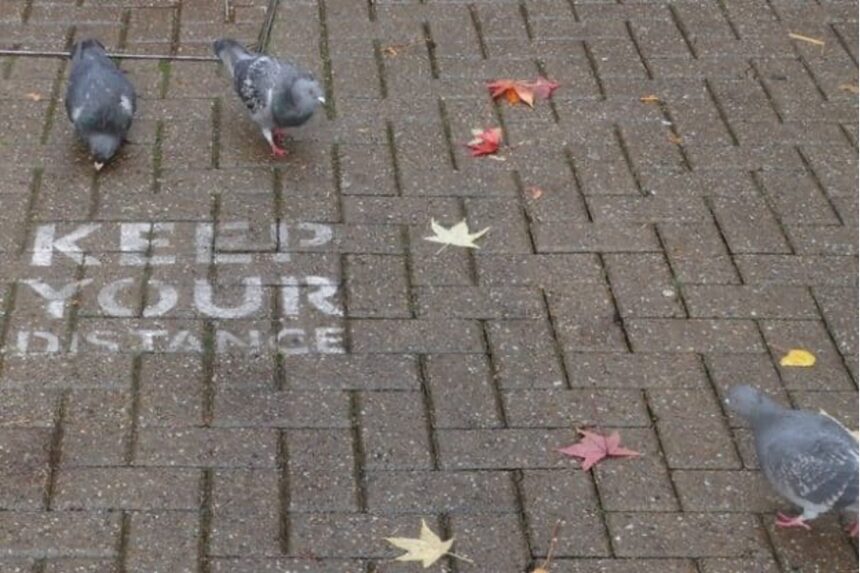First published in the NASGP Newsletter 26th June 2023

Photo by Carolyn Brown
On 5 May 2023 the World Health Organisation declared that Covid-19 was no longer a ‘public health emergency of international concern’. The same day our local convenience store took down the plastic screen which for three years had separated staff and customers. And that afternoon my sister’s Covid test was positive.
Most people have decided the pandemic is over. They have gone back to the ‘old normal’. Covid is no longer a prime topic of conversation or of consideration. My husband and I are among the few continuing to wear masks on public transport and in theatres. People are determined to travel and Ryanair has just ordered 300 new planes.
Governments have concluded that the pandemic is over. Most restrictions have been eased, Covid passes are no longer issued, the social distancing reminders on pavements fade into illegibility. It’s hard to get hold of a test, though it is still worth knowing if you have a cold or Covid. And we need to know if we are on the verge of a new wave. But the Office of National statistics no longer collects or reports on Covid numbers.

Lack of media coverage endorses the message that the pandemic is over. Unless a local paper is reporting the death of a prominent
resident you won’t find a mention. The Zoe Covid website still reports daily statistics (currently over 80,000 new infections a day), but Professor Tim Spector no longer does his regular video updates.
In 2023 the urge to ‘move on’ is very strong. As it was 105 years ago during the 1918 ‘Spanish’ flu pandemic. Then in 1920 a new flu variant appeared. Governments were reluctant to resume unpopular restrictions and a fourth wave killed even more than the deadly second wave. A new Covid wave, probably originating in a country with low vaccination rates, could sweep us away again.
Some pandemic-induced changes have become ‘the new normal’. Contactless payment – so convenient! On-line shopping! And what did we do before Zoom?
Other changes are finding their place.
In 2018, 5% of people worked from home; during lockdown everyone who could – that was 60% of us – were WFH. Some government ministers think everyone should now be back in the office.
Employers seem to vary in their approach. They may want to refill their half-empty office space, or recognise that WFH may well provide productivity, health and economic benefits for them as well as staff. Around half of working adults are now working at least part of their time at home. And some will continue to walk to work.
The pandemic gave telehealth a massive boost. Now that we are through the worst (let’s hope) the balance between on-line and face-to-face appointments should be for health professionals and patients to determine. Dog-whistle governmental decrees aren’t the way to organise consultations.
In 2020, the tone of the public discourse was the hope that we would ‘build back better’. If services could be reshaped there could be a gain from all that pain. Homes and public buildings would have better ventilation. Procurement and supply lines would be more efficient and flexible. Schools, hospitals, factories and offices would be better places to work. Formerly homeless people would have a roof over their head. Tragically little has changed.
We will be counting the social costs of the 2020-2021 lockdowns for years to come – isolation, increased social inequality, domestic violence, alcohol problems, PTSD, back problems. For many young people, blighted education has blighted life prospects. And each cohort has lost a different phase of growing up. In Japan, life-style coaches are teaching people who have worn masks for three years how to smile again.
‘There’s your science and my science’ is their mantra. No there isn’t.
There are other massive costs. Faced with another pandemic, a future government will have to overcome a legacy of civic mistrust of politicians. Another cost is opposition to vaccination. A few parents have always refused to have their children immunised, but Covid and social media have stirred up a population of aggressive anti- vaxxers prepared to threaten violence to those whose views don’t echo theirs. Especially if such views are based on scientific evidence. ‘There’s your science and my science’ is their mantra. No there isn’t. There’s one science – yes, subject to interpretation – or there is conspiracy theory. Will a future pandemic find another Dr Anthony Fauci, former Chief Medical Advisor, prepared to speak truth to power and to his fellow-Americans despite threats to his life and to his family?
In 2020 the nation clapped for the NHS. In 2022 people took out their frustrations on healthcare workers. In 2023, the violence seems to be declining, but security measures are likely to remain. At a time when both sides need understanding more than ever the relationship of trust between patients and their doctors has been prejudiced. How sad!
Is it coincidence that the NHS staff, teachers and rail staff, people most exposed to risk during the heat of the pandemic and now denied investment to get their services back to sustainability, have seen no option other than to withdraw their labour? Or is it unfeeling negligence?
WHO may have ended the period of emergency response, but Covid still has pandemic status. Its director-general Tedros Adhanom Ghebreyesus pointed out that until everyone is vaccinated no one will be safe. But even if infections stopped tomorrow, around two million Britons’ lives will continue to be limited by prolonged muscle ache, fatigue and cognitive dysfunction that typify long Covid. Some suffer speech problems or face-blindness. A GP friend experienced sudden brief severe pain at sites of past injuries which hadn’t been painful for decades: an ankle fracture, where a mole had been excised from her back and past dental treatments. Bizarre. The neurological ramifications of Covid seem to be manifold and strange. And worrying. Some people will need long-term care. There is a lot we don’t yet know about long Covid, but it seems that Covid not only damages endothelial cells leading to emboli, but also causes inflammation in the nervous system. We will be living with the effects of Covid for years,
In 2016 the Exercise Cygnus wargame tested the UK’s readiness to face an influenza pandemic. The government buried the Cygnus report, but we now know that the findings showed a lack of preparedness. Had the recommendations been acted upon, the response to Covid would have been less chaotic and many lives might have been saved.
Only an incurable optimist would hope that we will be better prepared for a future pandemic. And the next pandemic may well be bird flu.
Last summer on the Scottish coast we saw seabirds dying on the beaches. The virus is now endemic – farmed chickens pick it up from droppings from birds flying overhead. Some mammals have been infected and mammal-to-mammal transmission may be occurring. Bird flu is 100% fatal to birds and probably 50% fatal to mammals. If bird flu were to spread to humans, the worldwide seven million deaths from Covid so far, with thousands more every week, could pale into insignificance. Of the three genetic changes in the virus required for transmission to humans, one has already occurred. It is only a matter of time. The only mechanism for producing flu vaccines in scale uses eggs, but we are already short of eggs. Is anyone with the power to prepare paying attention?
: